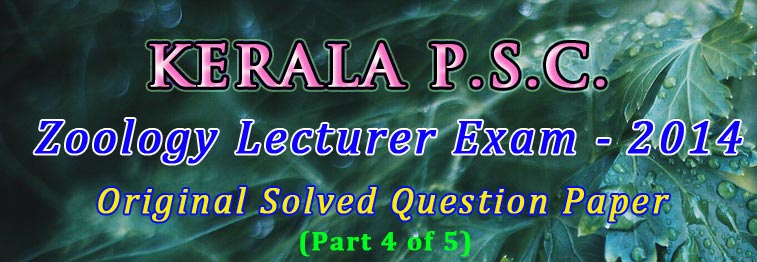
Kerala PSC Zoology Lecturer / Assistant Professor Recruitment Exam 2014
Question Paper (Q. Code 56/2014)
Original solved question paper of Kerala PSC Zoology Lecturer/Assistant Professor examination conducted by Kerala PSC (Kerala Public Service Commission) on 29/04/2014 (Question Paper Code 56/2014) for the appointment of Zoology Lecturer/Assistant Professor in Government Colleges of Kerala under the Directorate of Collegiate Education, Trivandrum, Kerala. Questions are in MCQ (Multiple Choice Questions) format.
Part – 4 of 5 (Questions 61 – 80)
61. A three dimensional image of a bacterium is achieved by using:
a. Phase contrast microscopy
b. Transmission electron microscopy
c. Scanning electron microscopy
d. Bright field microscopy
Ans. (c)
62. Tow dimensional gels are used to:
a. Separate DNA fragments
b. Separate DNA from RNA
c. Separate different proteins
d. Observe protein in two dimensions
Ans. (c)
63. In reversed phase HPLC:
a. A hydrophobic stationary phase is combined with a polar mobile phase
b. A hydrophobic stationary phase is combined with a polar mobile phase
c. A hydrophobic stationary phase is combined with a non-polar mobile phase
d. A hydrophilic stationary phase is combined with anon-polar mobile phase
Ans. (b)
64. Human genome comprise of:
a. 20 billion nucleotides
b. 5 million nucleotides
c. 3.1 billion nucleotides
d. 5 billion nucleotides
Ans. (c)
65. CpG islands and codon bias are tools used in eukaryotic genomics to
a. Final regular sequences
b. Identify a gen’s function
c. Identify open reading frames
d. Look for DNA binding domains
Question removed due to confusing question/incorrect options
66. The assembly of final genomics sequence form multiple sequencing running is called:
a. Annotating
b. Compiling
c. Computing
d. Sequencing
Ans. (b)
67. Which statement is incorrect about the SDS PAGE technique?
a. Sodium dodecyl sulfate is used to denature the samples being separated
b. It is used to separate proteins
c. It is a type of gas chromatographic method of separation
d. Separations are run on gel covered plates
Ans. (c)
Learn more: MCQ on Separation Techniques – Electrophoresis
68. Which of the following is a protein sequence database?
a. DDBJ
b. EMBL
c. Gen Bank
d. PIR
Ans. (d)
69. How many countries have ratified the Kyoto protocol of 1997 to date?
a. 275
b. 175
c. 75
d. 150
Question removed due to confusing question/incorrect options
70. Which protein has been produced generating a transgenic sheep that is used for replacement therapy for individuals at risk from emphysema?
a. Casein
b. α-anti trypsin (AAT)
c. Plaminogen activator (tPA)
d. Amyloid precursor proteins
Ans. (b)
71. Which of the following sampling method is preferred for studying heterogeneous population?
a. Simple random sampling
b. Stratified sampling
c. Convenient sampling
d. Systematic sampling
Ans. (b)
72. A test that examine subject’s thoughts and thought process is:
a. Cognitive test
b. Affective test
c. Standardized test
d. Generalized test
Ans. (a)
73. Which of the following is most appropriate about discussion part of a research paper?
a. It elaborates importance of the topic
b. Explain how the findings concur with that of others
c. Deals with method of sampling and recruitment
d. Deals with findings of the relevant studies
Ans. (b)
74. The process of collecting and analyzing information to develop or enhance a theory is:
a. Basic Research
b. Applied Research
c. Evaluation
d. None of the above
Ans. (a)
75. If you want to determine whether and to what degree a relationship exists between two or more variables what kind of study you have to do?
a. Descriptive
b. Correlation
c. Causal comparative
d. Experimental
Ans. (b)
76. Creating a class room climate conducive to develop positive self-concept in students is by:
a. Challenge and freedom
b. Respect and warmth
c. Control and success
d. All the above
Ans. (d)
77. Which of the following teacher will be liked most?
a. A teacher who maintain discipline in the classroom
b. A teacher who make teaching learning process enjoyable
c. A teacher who give more home work
d. A teacher who take more number of classes
Ans. (b)
78. An instructional model that identifies the major variable in the teaching learning process includes:
a. Individual differences
b. Principle of learning
c. Teacher behavior
d. All the above
Ans. (d)
79. The extent of teacher’s subject matter ad pedagogical expertise indicates the teachers:
a. Efficacy
b. Morale
c. Competency
d. Efficiency
Ans. (c)
80. What will be the impact of interactive teaching?
a. It will make teaching learning process difficult
b. It will create confusion among students
c. Students will be expected to listen only
d. It will make teaching learning process effective, democratic and friendly
Ans. (d)
Kerala PSC Zoology Lecturer 2014 Exam
| Part 1/5 | Part 2/5 | Part 3/5 | Part 4/5 | Part 5/5 |
